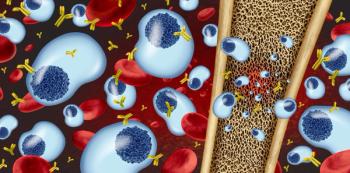
ASCO 2025: Vepdegestrant's Efficacy and Safety in ER+/HER2- Advanced Breast Cancer
Key Takeaways
- Vepdegestrant significantly extended progression-free survival and improved clinical benefit and objective response rates compared to fulvestrant in the VERITAC-2 trial.
- The oral administration of vepdegestrant resulted in fewer adverse events and gastrointestinal side effects, enhancing patient tolerability.
Compared with fulvestrant, vepdegestrant significantly extended progression-free survival and improved response rates.
Pharmacy Times® interviewed Erika Hamilton, MD, director of breast cancer research and executive chair of the Breast Cancer Research Executive Committee, Sarah Cannon Research Institute, who discussed recent VERITAC-2 (NCT05654623) trial findings, which were presented at the 2025 American Society of Clinical Oncology Annual Meeting, held in Chicago, Illinois. According to Hamilton, vepdegestrant (ARV-471; Arvinas, Pfizer) significantly extended progression-free survival (PFS) from 5.0 months compared with 2.1 months with fulvestrant (Faslodex; AstraZeneca), with a hazard ratio of 0.83 in patients. Clinical benefit rate nearly doubled to approximately 42%, and objective response rate (ORR) quadrupled to 18.6% with vepdegestrant. Vepdegestrant showed lower adverse events (AEs) and fewer gastrointestinal side effects compared to fulvestrant. The trial's implications for treatment sequencing and potential biomarker analyses were also highlighted.
Pharmacy Times: Can you introduce yourself?
Erika Hamilton, MD: I'm Dr. Erica Hamilton, and I'm the director of the Breast Cancer Research Program at Sarah Cannon Research Institute in Nashville, Tennessee.
Pharmacy Times: What key differences in efficacy outcomes were observed between vepdegestrant and fulvestrant in the VERITAC-2 study, particularly in progression-free survival and response rates?
Hamilton: So, the VERITAC-2 trial was a very simple design: 1:1 randomization, vepdegestrant, 200 mg orally, once daily in a continuous fashion, or fulvestrant, which is administered intramuscularly, 500 mg on days 1 and 15 of the first cycle, and then days 1 subsequently.
Our primary end point, as you mentioned, was progression-free survival (PFS) among those patients with ESR1 mutations, and this end point was met. PFS was not only statistically significantly lengthened but also clinically meaningfully lengthened from 5.0 months with vepdegestrant [to] only 2.1 months with fulvestrant. When we looked at PFS in all-comers and the intention-to-treat [cohorts], PFS was not dramatically changed, this was a hazard ratio of 0.83 that was not statistically significant.
We also met some key secondary end points, clinical benefit rate was more than doubled from 20% up to 42% with vepdegestrant among those patients with ESR1 mutations, and [the] ORR was actually more than quadrupled among the patients with ESR1 mutations, [from] 4% up to 18.6%.
Pharmacy Times: How does the safety and tolerability profile of vepdegestrant compare with fulvestrant, and are there any unique or notable adverse events pharmacists should monitor for?
Hamilton: That's a great question. So, fulvestrant is administered intramuscularly, so that can be a challenge for a lot of patients. Vepdegestrant is oral; it's taken at home, and we were really pleased to see that there were very low AEs. In terms of discontinuation and reduction, I really like to use that to measure how well a drug is tolerated. We saw only 3% of patients discontinue vepdegestrant, and we saw only 2% have to dose reduce. So, [this is] really an indication that this was well-tolerated. Our top 3 [AEs] were grade 1 fatigue, essentially, and we also saw nausea and [aspartate transaminase and alanine transaminase] elevations, but across all grades, this was only in the low teens. One of the other type of drugs in this space are the ulcers, and [these] really can have gastrointestinal [AEs] as a pretty prominent side effect. And so, this is really differentiated, because we do not see vomiting or diarrhea appear on our AE table, and that's because it was a less than 10% incidence across all grades, only 6% of each.
I'll also add 1 thing that pharmacists may want to pay attention to: we did have a QTc substudy. We can see the QTc prolonged just a little bit; it was 11 milliseconds, so not significantly. There was a QTc substudy with over 80 patients that looked at this, and the 90% upper limit of the confidence interval was still less than 20 milliseconds, and so, it was determined that this was not a significant QTc prolongation, so [this] probably shouldn't be clinically worrisome for patients.
Pharmacy Times: Given the PROTAC mechanism of action of vepdegestrant, how might its pharmacologic properties influence resistance patterns seen with other endocrine therapies?
Hamilton: A lot of times people want to group the PROTAC with the selective estrogen receptor degrader (SERD), and it's true that both of them are working to degrade the ER, but they do so in different ways. What's unique about vepdegestrant, a PROTAC proteolysis-targeting chimera, is that it binds the estrogen receptor on 1 side, and then the other side binds e3 ligase. When e3 ligase is brought into close proximity with the ER, this leads to ubiquitination and, ultimately, recruiting in the proteasome to kind of "chomp up" the ER and spit it out. So, there may be some advantages in certain mechanisms of resistance where this is advantageous for us.
Pharmacy Times: What implications do the VERITAC-2 findings have for sequencing vepdegestrant in the treatment paradigm for ER+/HER2- advanced breast cancer?
Hamilton: This was a registrational trial, again, in the essentially second- and third-line, although most patients were second-line immediately after CDK4/6 in combination with endocrine therapy. So, we do anticipate conversations with regulatory authorities about an approval here. Vepdegestrant also has the potential to be looked at in other settings, either in combination since it's an endocrine backbone that can easily combine with other drugs, whether those are PI3 kinase inhibitors or CDK4/6 inhibitors, [and so on]. Or we could also imagine this being brought up into earlier lines in combination with CDK4/6 in the first-line setting, or even in the adjuvant setting.
Pharmacy Times: Were any biomarker analyses conducted in the VERITAC-2 study, and could they help guide patient selection for vepdegestrant therapy in clinical practice?
Hamilton: Biomarker analyses are always really key. We just got the clinical data from this trial, and there are samples collected for these biomarkers, but that has not been performed yet. So, really the only biomarker we have right now to comment on VERITAC-2 is that the benefit really seemed to be for those patients that had an ESR1 mutation, but they will be looking at other mutations and subsequent biomarker analyzes to come out in future presentations.
Pharmacy Times: Any final or closing thoughts?
Hamilton: Yeah, I [want to] give you a little bit of background just why this is an important study. Essentially, in the second-line, post-CDK4/6 setting, there's not a consensus of what therapies to use. Previously, fulvestrant was really one of our mainstays, and [it] has some disadvantages [such as] the intramuscular administration. Specifically, across multiple randomized trials, we now see that fulvestrant has a PFS of 2 months or less, and so, really not good enough for our patients. And so, this is why the VERITAC-2 trial was born.
Newsletter
Stay informed on drug updates, treatment guidelines, and pharmacy practice trends—subscribe to Pharmacy Times for weekly clinical insights.




















































































































































































































